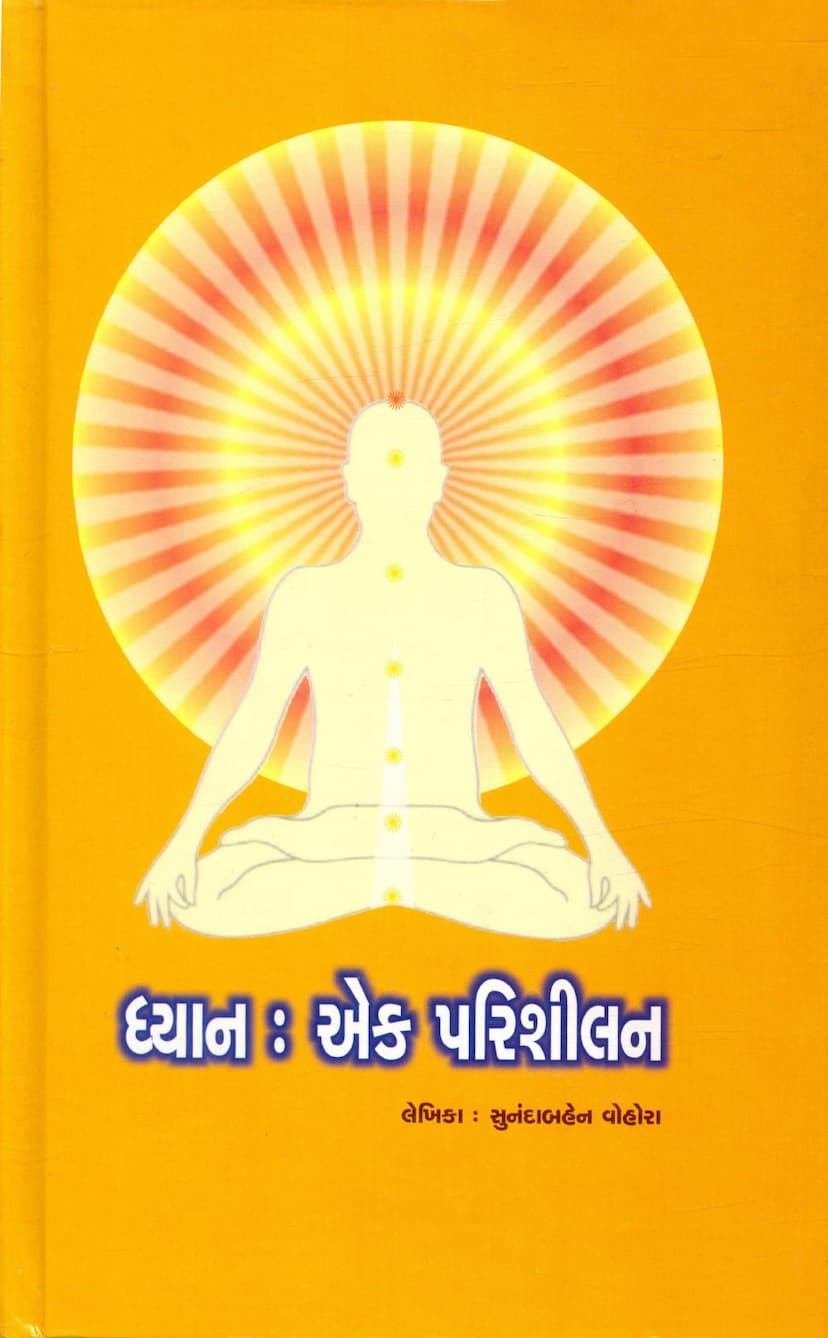Dhyan Ek Parishilan
Added to library: September 1, 2025

Summary
The book "Dhyan Ek Parishilan" (Meditation: An Examination) by Sunandaben Vohra, published by Deepakbhai & Dharmiben Shah USA, is a profound exploration of meditation from a Jain philosophical and practical perspective. The book aims to guide readers into the world of inner peace and self-realization through the practice of meditation.
Here's a comprehensive summary based on the provided text:
Core Message and Definition of Meditation:
- Self-Realization is Meditation: The book defines meditation as the process of trying to understand and realize one's true self. It's an experience of one's own nature and qualities on the background of absolute stillness (Nirvikalpa).
- Overcoming External Distractions: The text emphasizes that our attention is constantly drawn to external objects and sensations. Just as the sound of a flowing stream can be drowned out by a loud procession, our inner peace and joy (ananda) can be obscured by external preoccupations. True meditation involves withdrawing this attention from the external world and bringing it inwards.
- Inner Joy is Always Present: The book asserts that joy is an inherent part of our true nature, a constant stream flowing within us. The practice of meditation is about accessing this internal source.
The Path to Meditation:
- Mindfulness in Daily Activities: The book advises that even mundane activities like eating can be done mindfully. When eating, the food will naturally go to the mouth and the body's mechanisms will handle the digestion. There's no need to engage the mind excessively in the process itself, which can lead to attachment to taste and aversion to unpleasant food. Instead, the mind can be directed towards devotional verses or other positive contemplations.
- Withdrawal of External Focus: A crucial aspect of meditation is the conscious effort to draw one's attention away from external objects and desires. The text suggests that external things have no inherent power to attract us; it's our ingrained habits and conditioning that pull us outwards.
- The Inner World: Once we enter the joyful world of our inner self, we are no longer drawn to external distractions.
Key Principles and Guidance:
- Simplicity and Accessibility: Sunandaben Vohra presents the definition of meditation and the ways to enter it in a very simple and accessible manner.
- Spiritual Journey: The book is described as an invitation to enter the world of the self, offering practical guidance.
- Importance of Gurus and Tradition: The text highlights the importance of seeking guidance from experienced individuals and following the established Jain traditions. The author's own spiritual journey is interwoven with encounters with various spiritual masters.
- The Goal of Eternal Happiness: The ultimate aim of meditation is to attain eternal and self-reliant happiness, which can be achieved through self-knowledge and self-meditation.
- Overcoming Misconceptions: The book addresses common misconceptions about meditation, such as the idea that it can be achieved instantly or through external means like "shaktipat" (transfer of spiritual energy). It stresses that true meditation requires sincere effort, discipline, and inner purification.
- The Role of Viveka (Discrimination): The text underscores the significance of viveka, the ability to discern the true from the false, the self from the non-self. This is crucial for navigating the spiritual path.
- Inner Purity and Balance: Beyond concentration, the book emphasizes the importance of purity and calmness of mind. A balanced approach in daily actions, free from stress and pressure, is essential for progress.
- The Nature of True Joy: True joy is not derived from external possessions or achievements but from inner realization and connection with the self.
Author's Spiritual Journey and Influences:
The book's author, Sunandaben Vohra, has a rich spiritual background, having practiced meditation under the guidance of various renowned spiritual masters. Her journey is marked by periods of silent meditation in the Himalayas and encounters with figures like Pandit Sukhlalji, Panachand Shah, and Pannalal Gandhi. She also mentions the influence of Acharya Kalapurnasuri and Acharya Bhadrankarsuri. Her personal experiences and the wisdom gleaned from these interactions form the foundation of this book.
Key Themes and Chapters (as per Index):
- Introduction to Meditation: Setting the stage for the exploration of meditation.
- Dispelling Illusions: Addressing common misconceptions about meditation.
- Meditation in Jainism: The specific context and practice of meditation within the Jain tradition.
- Meditation as Right Faith, Knowledge, and Conduct: Integrating meditation into the core tenets of Jainism.
- Mind Purification and Self-Observation: The importance of internal cleansing and introspection.
- Mind Stability in Meditation: Techniques and principles for achieving mental stillness.
- Meditation as the Path to Liberation: The ultimate purpose of meditation in the Jain path.
- The Mystery of Meditation: Unveiling deeper aspects of the practice.
- Introduction to Meditation Practice: Practical steps and guidance.
- Appendices: Summaries of various texts and philosophical concepts related to meditation.
- Conclusion: Summarizing the essence and significance of meditation.
Overall, "Dhyan Ek Parishilan" is presented as a guide for spiritual seekers, offering a clear, simple, and practical approach to meditation rooted in the rich philosophical tradition of Jainism. It encourages readers to embark on an inner journey of self-discovery and experience the profound peace and happiness that lies within.